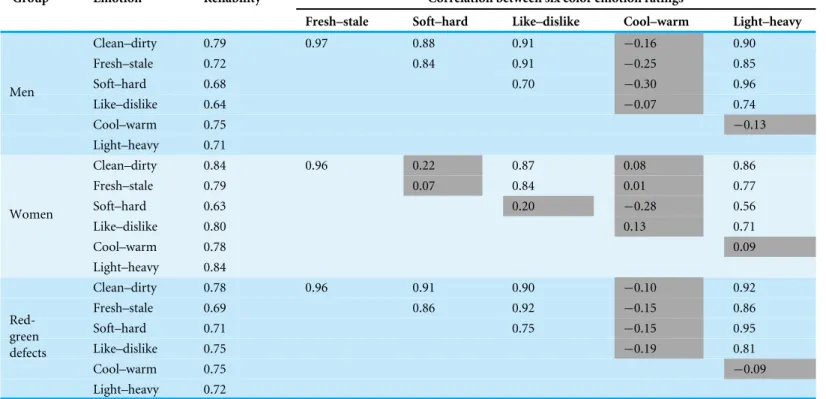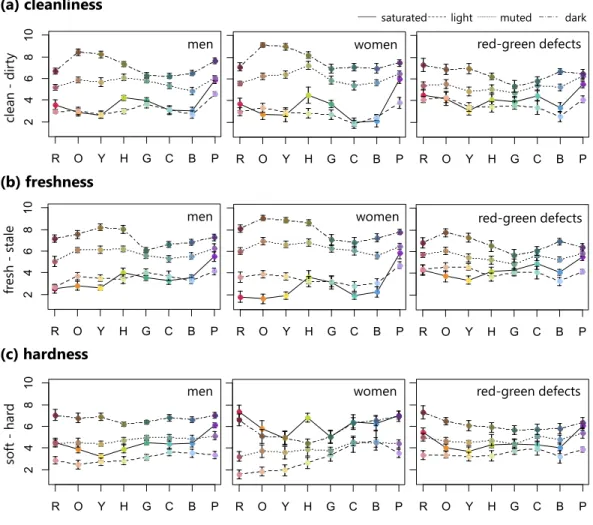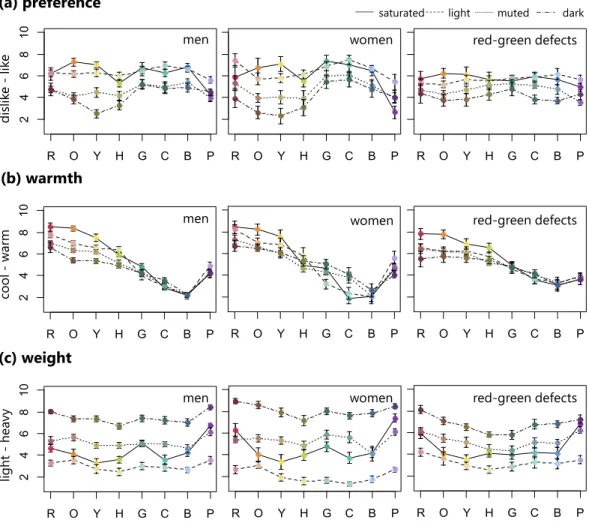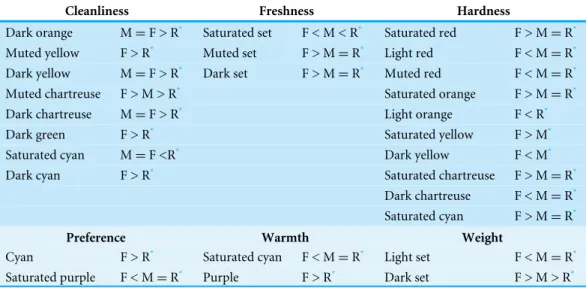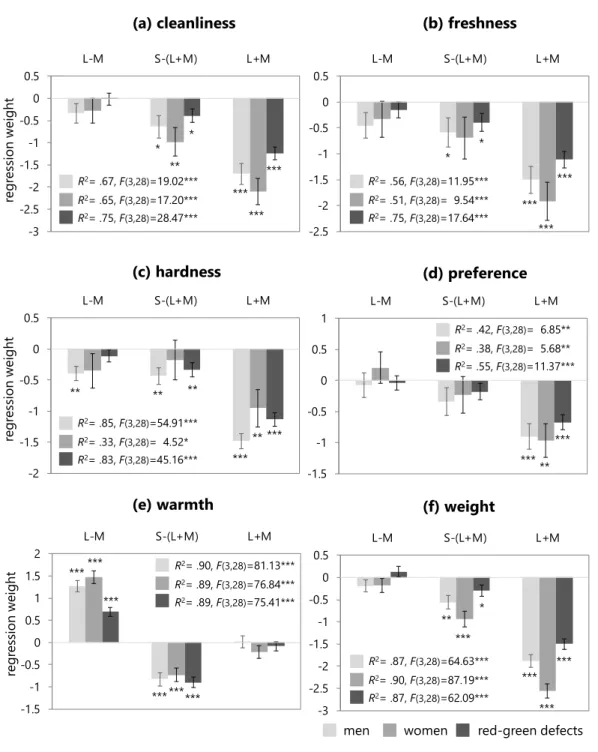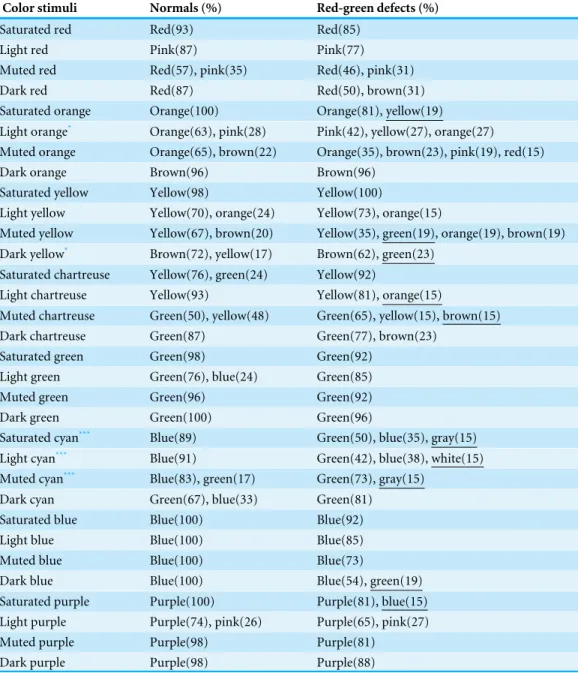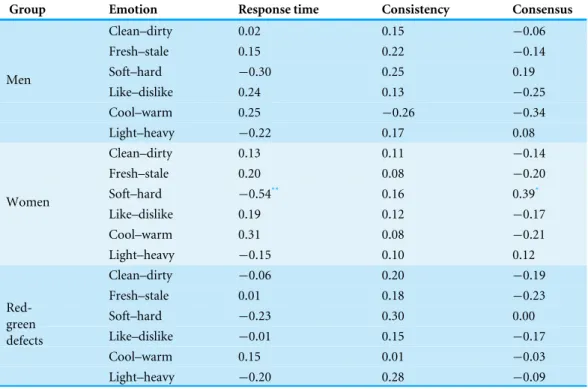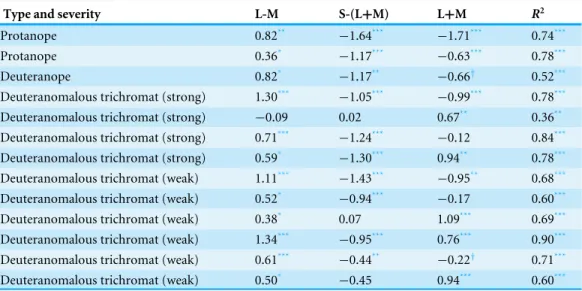Submitted14 June 2016
Accepted 3 November 2016
Published8 December 2016
Corresponding author
Keiko Sato,
satokei@eng.kagawa-u.ac.jp
Academic editor
Jafri Abdullah
Additional Information and Declarations can be found on page 20
DOI10.7717/peerj.2751
Copyright
2016 Sato and Inoue
Distributed under
Creative Commons CC-BY 4.0
OPEN ACCESS
Perception of color emotions for single
colors in red-green defective observers
Keiko Sato1and Takaaki Inoue2
1Faculty of Engineering, Kagawa University, Takamatsu, Kagawa, Japan
2Graduate School of Engineering, Kagawa University, Takamatsu, Kagawa, Japan
ABSTRACT
It is estimated that inherited red-green color deficiency, which involves both the protan and deutan deficiency types, is common in men. For red-green defective observers, some reddish colors appear desaturated and brownish, unlike those seen by normal observers. Despite its prevalence, few studies have investigated the effects that red-green color deficiency has on the psychological properties of colors (color emotions). The current study investigated the influence of red-green color deficiency on the following six color emotions: cleanliness, freshness, hardness, preference, warmth, and weight. Specifically, this study aimed to: (1) reveal differences between normal and red-green defective observers in rating patterns of six color emotions; (2) examine differences in color emotions related to the three cardinal channels in human color vision; and (3) explore relationships between color emotions and color naming behavior. Thirteen men and 10 women with normal vision and 13 men who were red-green defective performed both a color naming task and an emotion rating task with 32 colors from the Berkeley Color Project (BCP). Results revealed noticeable differences in the cleanliness and hardness ratings between the normal vision observers, particularly in women, and red-green defective observers, which appeared mainly for colors in the orange to cyan range, and in the preference and warmth ratings for colors with cyan and purple hues. Similarly, naming errors also mainly occurred in the cyan colors. A regression analysis that included the three cone-contrasts (i.e., red-green, blue-yellow, and luminance) as predictors significantly accounted for variability in color emotion ratings for the red-green defective observers as much as the normal individuals. Expressly, for warmth ratings, the weight of the red-green opponent channel was significantly lower in color defective observers than in normal participants. In addition, the analyses for individual warmth ratings in the red-green defective group revealed that luminance cone-contrast was a significant predictor in most red-green-defective individuals. Together, these results suggest that red-green defective observers tend to rely on the blue-yellow channel and luminance to compensate for the weak sensitivity of long- and medium-wavelength (L-M) cone-contrasts, when rating color warmth.
SubjectsNeuroscience, Psychiatry and Psychology, Statistics
Keywords Color emotion, Color vision, Color naming, Red-green color deficiency
INTRODUCTION
complete or partial loss of sensitive function (Neitz & Neitz, 2011). The type of cone that is lost or replaced by an anomalous photopigment defines different defects; a complete loss of cone function is called dichromacy, while a partial loss is called anomalous trichromacy (Merbs & Nathans, 1992). The most common color vision deficiencies are the protan and deutan types. The protan type, which includes protanopia and protanomaly, is caused by the replacement of the normal L gene with the M pigment gene or with an anomalous pigment gene. In contrast, in the deutan type, the normal M gene is replaced with the L pigment gene (deuteranopia), or with an anomalous pigment gene (deuteranomaly) (Neitz & Neitz, 2011;Smith & Pokorny, 2003). Individuals characterized as protan or deutan types are called red-green color vision defects. Red-green color vision defects are classified into the following four types: protanope, deuteranope (red-green dichromat), protanomalous, or deuteranomalous (red-green anomalous trichromats) (Neitz & Neitz, 2011). The incidence of deuteranomaly is the highest of four types (Neitz, Neitz & Kainz, 1996;Sharpe et al., 1999). Deuteranomalous individuals have varying degrees of trichromatic color vision with great variation. This differentiation stems from the S pigments and two narrowly separated photopigments that absorb in the L wavelength region of the spectrum. The severity of the deuteranomalous defect depends on the degree of similarity among the residual photopigments (Neitz, Neitz & Kainz, 1996).
Further study by Álvaro et al. (2015)investigated the color preference of red-green dichromats. The results suggested that dichromats have different preferences than that of those with normal color vision; dichromats rated yellow best, unlike normal individuals. The authors examined color preference ratings for red-green dichromats and those with normal vision according to the fundamental neural dimensions that underlie color coding in the human visual system, which are mainly L-M and S-(L+M) cone-contrasts. The L-M cone-contrasts span from red to green approximately, while the S-(L+M) contrasts span from yellow to blue approximately. The color preference of red-green dichromats using two cone-contrasts based on a trichromatic model was additionally modeled byÁlvaro et al. (2015); this resulted in failure as predicted. They also investigated whether corrected variables calculated based on dichromats’ cone responses (including lightness and saturation perception) could predict color preferences. The results showed that blue-yellow mechanism activity (an estimation for dichromats’ saturation perception) could explain the high variance in dichromats’ color preference. Other recent studies on normal trichromats have also used this method of examining color preference based on cone-contrast (Hurlbert & Ling, 2007;Palmer & Schloss, 2010;Taylor, Clifford & Franklin, 2013). Color preference based on vision characteristics should focus on cone-contrasts to better elucidate this mechanism.
In addition to color preference, individuals can also express various affective meanings of color, that is, color emotions which are defined as feelings evoked by colors (Ou et al., 2004). For instance, reddish colors are commonly called warm colors, while blue or greenish blue are cool colors. As another example, white, yellow, and light blue feel lighter in weight than do dark colors (Wright, 1962). Many experimental psychologists and psychometricians have explored the affective meaning of color using the semantic differential (SD) method introduced byOsgood, Suci & Tannenbaum (1957), as well as factor analysis (Wright & Rainwater, 1962) and principal component analysis (Hogg, 1969). These studies have attempted to identify the affective meanings of color using adjectives, summarizing various meanings based on evaluation, activity, warmth, impact, and so on. Several studies have also revealed a relation between adjectives or extracted factors and perception of color hue, lightness, and saturation (chroma) (Ou et al., 2004;Xin et al., 2004;Gao & Xin, 2006). However, no study to date has examined color emotions in red-green defective observers. Previously, the author has explored the af-fective color meanings of stimuli from the International Commission on Illumination 1976 (L*, u*, v*) color space (CIE LUV) in a small sample of individuals and suggested that it is highly likely that there are differences between normal and red-green defective observers for the perceived warmth a color has (Sato, Takimoto & Mitsukura, 2015).
each one using 11 common basic color terms (BCTs). Six bipolar adjectives representing color emotions based on the study byOu et al. (2004)were used as follows: clean–dirty (cleanliness), fresh–stale (freshness), soft–hard (hardness), like–dislike (preference), cool– warm (warmth), and light–heavy (weight). The resultant ratings were compared across groups. Then, using linear regression, ratings were predicted based on the cone-contrast model, consisting of red-green, blue-yellow, and luminance contrasts, and considered in terms of regression weights. Additionally, color emotion ratings were explored with regard to color naming behavior in the red-green defective group.
MATERIALS AND METHODS
SubjectsThe participants, all Japanese, included 13 men and 10 women with normal vision, and 13 men who were red-green defective observers, including both the protan and deutan types. Age is a potential factor influencing color preference, especially between younger and older women (Hurlbert & Owen, 2003). Thus, participants were sampled within a range of 20–40 years as much as possible. The mean ages in the normal men, normal women, and red-green defective observers were 23.23 years (SD=4.00), 26.50 years (SD=6.70), and
23.92 years (SD=7.01), respectively, within an age range of 18–43 years. All participants
were tested using Ishihara pseudoisochromatic plates. In addition, red-green defective individuals underwent testing with the Anomaloscope (NEITZ OT-ll) and then were diagnosed with the type and severity of color vision deficiency according to their matching, identifying two protanopes, one deuteranope, and 10 deuteranomalous trichromats. Red-green defective participants included all types of defects and severity as listed above. Written informed consent was obtained from all participants on an experimental protocol that was approved by the Ethics Committee of Kagawa University (26-002).
Equipment and stimuli
A computer (DELL Optiplex 9020) controlled test instrument and a calibrated monitor (EIZO ColorEdge CX270 with a resolution of 1,900×1,200 pixels), were used. Stimuli
included 32 colors from the BCP (Palmer & Schloss, 2010), composed of saturated, light, muted, and dark samples of eight hues: red (R), orange (O), yellow (Y), chartreuse (H), green (G), cyan (C), blue (B), and purple (P). These eight hues were made up of the four Hering primaries (Stockman & Brainard, 2010), R, G, B, and Y, as well as four well-balanced binary hues, O, H, C, and P. The four color sets (i.e., saturated, light, muted, and dark) were defined by cutting color space that differed in the saturation and lightness levels. The 32 color stimuli in the current experiment were simulated as closely as possible on the monitor, which was white calibrated as a reference (x=0.31,y=0.32,Y =99.93 cd/m2).
between the participant and the screen, and color stimuli were presented at the center of the monitor at the participant’s eye level.
Procedure
The participants completed two tasks, which included a color naming and an emotion rating task involving six subtasks for six emotions, with roughly 1-minute intervals between tasks. The experiment was replicated at least two hours after the first measurement, with a reversal of the task order. Color stimuli were presented individually on a gray background (x=0.32,y=0.32,Y=19.07 cd/m2).
In the color naming task, participants selected one color name from the 11 BCTs using a computer mouse: red, yellow, green, blue, purple, brown, orange, pink, black, white, and gray. These BCTs have been used for color naming across different languages and geographical locations (Berlin & Kay, 1969;Uchikawa & Boynton, 1987), and even across different color vision types (Bonnardel, 2006;Lillo et al., 2001;Lillo et al., 2014). In the present experiment, the buttons for the 11 BCTs were presented in Japanese below the color stimuli:aka(red),midori(green),ki(yellow),ao(blue),daidai(orange),momo(pink),
murasaki(purple),tya(brown),kuro(black),hai(gray), andshiro(white). Participants responded by clicking on the color name as rapidly as possible. The buttons representing the color names (with each size being 2.1 degrees horizontal and 1.8 degrees vertical) were presented in a horizontal line with the order mentioned above. The order and position of each button was not changed throughout the task.
During the emotion rating task, participants rated six emotions using the bipolar adjectives. Six adjective pairs were chosen from a previous study byOu et al. (2004), and presented in Japanese as follows:kirei-kitanai(clean–dirty),shinsen-furukusai(fresh–stale),
yawarakai-katai(soft–hard),suki-kirai(like–dislike),tumetai-atatakai(cool–warm), and
karui-omoi(light–heavy). The rating task for each emotion was carried out as a separate subtask, and counterbalanced across participants. Participants were instructed to rate their emotion for each stimulus by moving the mouse cursor along a horizontal bar representing an emotional range from zero to ten (17.9 degrees horizontal and 1.6 degrees vertical). For instance, in the case of asuki-kirai(like–dislike) rating, zero and ten describe ‘‘totemo suki(like very much)’’ and ‘‘totemo kirai(dislike very much),’’ respectively. The default position was set to the center of the bar, indicating neutral.
In both tasks, before the color stimuli appeared, a 500-ms fixation cross (1.3 degrees diameter) was presented. In the color naming task, color stimuli were presented for 10-s. If there was no response within the 10-s duration, the next stimulus was presented. In the emotion rating task, participants performed without a time limit, but were asked to respond as quickly as possible.
RESULTS
Reliability and correlation between six color emotion ratings
Table 1 Reliability and correlation between six color emotion ratings.Reliabilities (correlation coefficient between the first and second ratings) for six emotions were all significant (p< .001). In a correlation between six color emotion ratings, shaded cells indicate that no statistically signifi-cance were detected. The others were all significant (p< .01).
Group Emotion Reliability Correlation between six color emotion ratings
Fresh–stale Soft–hard Like–dislike Cool–warm Light–heavy
Clean–dirty 0.79 0.97 0.88 0.91 −0.16 0.90
Fresh–stale 0.72 0.84 0.91 −0.25 0.85
Soft–hard 0.68 0.70 −0.30 0.96
Like–dislike 0.64 −0.07 0.74
Cool–warm 0.75 −0.13
Men
Light–heavy 0.71
Clean–dirty 0.84 0.96 0.22 0.87 0.08 0.86
Fresh–stale 0.79 0.07 0.84 0.01 0.77
Soft–hard 0.63 0.20 −0.28 0.56
Like–dislike 0.80 0.13 0.71
Cool–warm 0.78 0.09
Women
Light–heavy 0.84
Clean–dirty 0.78 0.96 0.91 0.90 −0.10 0.92
Fresh–stale 0.69 0.86 0.92 −0.15 0.86
Soft–hard 0.71 0.75 −0.15 0.95
Like–dislike 0.75 −0.19 0.81
Cool–warm 0.75 −0.09
Red-green defects
Light–heavy 0.72
and significant in all groups (allp< .001). In addition, a correlation matrix was calculated to quantify the relationships between the ratings of the six adjectives for all groups (see correlation matrix between six emotions inTable 1). In the trichromatic male and red-green defective groups, only the warmth ratings showed no significant correlation to any other emotions. On the other hand, in the female observers, the hardness ratings also did not reveal any significant correlations to the other emotions except for the weight ratings. The other correlations were all significant (allp< .01).
Color emotion ratings for normal and red-green defective observers
Figures 1and2show the average color emotion ratings within each group of the four sets of colors (i.e., saturated, light, muted, and dark) along all eight hues (i.e., R, O, Y, H, G, C, B, and P). For cleanliness (clean–dirty) ratings in the trichromatic individuals, including men and women, the saturated and light samples were assessed as cleaner, with the exception of saturated purple, compared with the muted and dark colors, which were assessed as dirtier, regardless of hue. For both men and women, dark orange was rated the dirtiest. The red-green defective observers’ ratings were more varied across the four color sets, specifically in the green to cyan range, than were those of the normal participants. For the red-green defects, dark red was identified as dirtier, while light blue was the cleanest.
2
468
10
R O Y H G C B P
24
6
8
10
R O Y H G C B P
24
6
8
10
R O Y H G C B P
R O Y H G C B P
R O Y H G C B P
R O Y H G C B P
R O Y H G C B P
R O Y H G C B P
R O Y H G C B P
men
saturated light muted dark
clean
-d
irty
(a) cleanliness
(b) freshness
(c) hardness
red-green defects
fresh
-s
tale
so
ft
-har
d
women
men women red-green defects
men women red-green defects
Figure 1 Mean ratings of cleanliness, freshness, and hardness (error bar means SEM) for 32 BCP col-ors consisting of saturated, light, muted, and dark sets.Row means eight hues. These ratings were aver-aged for male, female, and red-green color defective observers separately.
ratings, normal individuals rated the saturated and light samples as fresher, with the exception of saturated purple, while the muted and dark samples were rated as staler. For the red-green defective observers, light blue was rated the freshest, which was the same as in the cleanliness ratings, while dark orange was the stalest.
As for hardness (soft–hard), the normal men and red-green defective observers rated the light color sets as all softer, while the dark color sets were rated as harder. On the other hand, the female observers rated the saturated and dark color samples as harder compared with the light and muted sets.
24
6
8
10
R O Y H G C B P
24
6
8
10
R O Y H G C B P
24
6
8
10
R O Y H G C B P
R O Y H G C B P
R O Y H G C B P
R O Y H G C B P
R O Y H G C B P
R O Y H G C B P
R O Y H G C B P
saturated light muted dark
dislik
e
-lik
e
(a) preference
(b) warmth
(c) weight
cool
-w
arm
light
-heavy
men women red-green defects
men women red-green defects
men women red-green defects
Figure 2 Mean ratings of preference, warmth, and weight (error bar means SEM) for 32 BCP colors consisting of saturated, light, muted, and dark sets.Row means eight hues. These ratings were averaged for male, female, and red-green color defective observers separately.
For all groups, the warmth (cool–warm) rating patterns steadily decreased from warm to cool in the red to blue range, but purple increased in warmth. Male observers tended to rate red, orange, and yellow hues in decreasing warmth according to the following order: saturated (warmest), light, muted, and dark (coolest). In addition, the women’s ratings varied across four sets in green and cyan hues. The four color sets (i.e., saturated, light, muted, and dark) were not as clearly separated by warmth ratings in the red-green defective observers.
For weight (light–heavy) ratings, all groups seemed to assign weight based on the four color sets. The light colors were rated lighter, while the dark color sets were heavier.
Table 2 Observerd differences between groups.M, F, and R stand for males, females, and red-green de-fective observers, respectively.
Cleanliness Freshness Hardness
Dark orange M=F > R* Saturated set F < M < R* Saturated red F > M=R*
Muted yellow F > R* Muted set F > M
=R* Light red F < M=R*
Dark yellow M=F > R* Dark set F > M=R* Muted red F < M=R*
Muted chartreuse F > M > R* Saturated orange F > M
=R*
Dark chartreuse M=F > R* Light orange F < R*
Dark green F > R* Saturated yellow F > M*
Saturated cyan M=F <R* Dark yellow F < M*
Dark cyan F > R* Saturated chartreuse F > M
=R*
Dark chartreuse F < M=R*
Saturated cyan F > M=R*
Preference Warmth Weight
Cyan F > R* Saturated cyan F < M
=R* Light set F < M=R*
Saturated purple F < M=R* Purple F > R* Dark set F > M > R*
Notes.
*p< .05.
significant interaction effects that involved group differences (i.e., color set×group, hues
×group, or color set×hues×group) were evaluated and are discussed here. Therefore,
main effects of color set and hues, as well as the color set×hue interaction are not discussed.
In addition, observed differences between groups based on Bonferroni-corrected pairwise comparisons are shown inTable 2.
For cleanliness ratings, the analysis showed a significant three-way interaction between group, color set, and hue (F(42,693)=2.17,p< .001, η2G=0.04). To examine the
three-way interaction, post-hoc two-way ANOVAs using the mean ratings of each hue were conducted with set and group as factors. The results revealed a significant interaction of group and color set on orange, yellow, chartreuse, green, and cyan (orange:F(4.71,77.74)=5.69,p< .001, ηG2=0.18; yellow:F(3.70,61.11)=3.46,p< .05,
η2G=0.12; chartreuse:F(4.33,71.47)=3.85,p< .01, η2G=0.12; green:F(4.38,72.23)=
2.99,p< .05, ηG2 =0.10; cyan: F(4.67,77.05)=7.19,p< .001, ηG2 =0.16). Simple
effects showed that there were group differences on the dark sets for orange, yellow, chartreuse, green, and cyan (orange: F(2,33)=10.09,p< .001, ηG2 =0.38; yellow: F(2,33)=6.67,p< .01, η2G=0.29; chartreuse: F(2,33)=11.25,p< .001, ηG2 =0.41;
green:F(2,33)=3.90,p< .05, η2G=0.19; cyan:F(2,33)=3.73,p< .05, η2G=0.18), on
the muted sets for yellow, and chartreuse (yellow:F(2,33)=3.97,p< .05, η2G=0.20;
chartreuse: F(2,33)=9.18,p< .001, η2G=0.36), and on the saturated sets for cyan
(F(2,33)=8.56,p< .01, η2G=0.34).
For freshness ratings, the interaction of group and color set was significant (F(6,99)=9.93,p< .001, ηG2 =0.34). Post-hoc one-way ANOVAs with group as a
(saturated:F(2,33)=13.12,p< .001, ηG2=0.16; muted:F(2,33)=6.94,p< .01, ηG2=
0.08; dark:F(2,33)=7.24,p< .01, η2G=0.14).
The ANOVA for the hardness ratings revealed the significant interaction between group, color set, and hue (F(42,693)=1.75,p< .01, η2G=0.03). To examine the
three-way interaction, post-hoc two-three-way ANOVAs using the mean ratings of each hue were conducted with set and group as factors. The results revealed a significant interaction of group and color set on red, orange, yellow, chartreuse, and cyan (red:F(6,99)=6.84,p<
.001, η2G=0.19; orange:F(4.64,76.51)=4.30,p< .01, η2G=0.15; yellow:F(3.95,65.24)=
3.71,p< .01, ηG2 =0.14; chartreuse:F(4.79,79.10)=7.56,p< .001, ηG2 =0.23; cyan: F(4.24,69.98)=3.10,p< .05, η2G=0.08). Simple effects showed that there were group
differences on the saturated color sets for red, orange, yellow, chartreuse, and cyan (red:
F(2,33)=9.20,p< .001, η2G=0.36; orange:F(2,33)=4.63,p< .05, η2G=0.21; yellow: F(2,33)=3.84,p< .05, η2G=0.19; chartreuse: F(2,33)=19.38,p< .001, ηG2 =0.54;
cyan: F(2,33)=4.24,p< .05, η2G=0.20), on the light sets for red and orange
(red:F(2,33)=5.30,p< .05, ηG2 =0.24; orange:F(2,33)=4.04,p< .05, ηG2=0.20)
on the muted sets for red (F(2,33)=5.47,p< .01, η2G=0.25), and on the dark sets
for yellow and chartreuse (yellow: F(2,33)=4.00,p< .05, ηG2 =0.20; chartreuse: F(2,33)=6.75,p< .01, η2G=0.29).
For the preference (like-dislike) ratings, there was a significant three-way interaction between group, color set, and hue (F(42,693)=1.70,p< .01, η2G=0.03). The post-hoc
two-way ANOVAs using the mean ratings of the eight hues were conducted with color sets and group as factors. These results showed that for the cyan color, there was a significant group difference (F(2,33)=5.30,p< .05, η2G=0.12) and for the purple color, group
and color set interacted significantly (F(6,99)=2.54,p< .05, η2G=0.08). Simple effects
revealed group differences on the saturated color only (F(2,33)=5.17,p< .05, η2G=0.24).
The ANOVAs for the warmth (cool-warm) ratings also revealed a significant three-way interaction between group, color sets and hue (F(42,693)=1.44,p< .05, η2G=0.03). The
post-hoc two-way ANOVAs with color sets and group as factors were done on the mean ratings of the eight hues. These results revealed that for the cyan color, group and color set interacted (F(4.07,67.20)=2.29,p=.067, ηG2=0.07). Simple effects showed group
differences on the saturated set (F(2,33)=5.57,p< .01, η2G=0.25). Furthermore, there
was a significant group difference for purple (F(2,33)=3.57,p< .05, η2G=0.04).
For weight ratings, the interaction between group and color set was significant (F(4.42,72.96)=5.34,p< .001, η2G=0.08). Post-hoc one-way ANOVAs showed that
there was a significant group difference for the light and dark sets (light: F(2,33)=
5.96,p< .01, η2G=0.14; dark:F(2,33)=10.44,p< .001, η2G=0.18).
Prediction of color emotions based on three cone-contrast values
-0
.6
-0
.2
0.
2
0.
6
R O Y H G C B P
saturated light muted dark
-3
-2
-1
0123
R O Y H G C B P
saturated light muted dark
-4
-2
0
2
4
R O Y H G C B P
saturated light muted dark
cone-contrast
(a) L-M (b) S-(L+M) (c) L+M
Figure 3 Three cone-contrast values of 32 BCP colors.(A–C) show L-M (red-green contrast), S-(L+M) (blue-yellow contrast), and L+M (luminance contrast), respectively.
color preference by weights on two cone-contrasts, and Álvaro et al. (2015)andTaylor, Clifford & Franklin (2013) examined color preferences in terms of two cone-contrasts, lightness, and saturation values.Palmer & Schloss (2010)also used the two cone-contrast values, lightness, and saturation as predictors. In the present study, the two dimensions consisting of L-M and S-(L+M) cone-contrasts and the luminance cone-contrast value (lightness) was included. Because color emotions such as hardness or weight ratings may have a strong relation to lightness (Ou et al., 2004;Gao & Xin, 2006), and lightness of color has an influence on most color emotions (Xin et al., 2004).
Three cone-contrast values were calculated as follows according to the procedure of
Álvaro et al. (2015). Firstly, the CIEx,y, andY values were translated to the amount of L, M, and S cone excitations using Smith and Pokorny’s cone fundamentals (Smith & Pokorny, 1975). Secondly1L,1M, and1S, representing differences between each stimulus and the background were calculated using the following equations:1L=(Ls−Lb)/Lb,
1M=(Ms−Mb)/Mb, and1S=(Ss−Sb)/Sb. The subscript ‘s’ in the equations stands
for the stimulus, while the subscript ‘b’ stands for the background color. Lastly, three cone-contrast values were calculated according to the cone-contrast weights that had been defined byEskew, Mclellan & Giulianini (1999).Figure 3shows the three cone-contrast values for the four color sets and eight hues.
The three cone-contrast values were used as predictors of the mean ratings for the six color emotions averaged within each group using linear regression. The resultant standardized regression coefficients, coefficients of determination (Rsquared), andF
statistics are shown inFig. 4. The prediction model that included the three cone-contrasts accounted for all emotion ratings significantly. Specifically, for the warmth and weight ratings, this model accounted for the high variances by more than 87% in all groups. The models for the cleanliness and hardness ratings also accounted for the high variances within a range of 65–85% with the exception of the hardness rating in the female group. For the freshness ratings, the model explained just half of the variances in the trichromatic group, while a higher variance was found in the red-green defective observers. Lastly, for the preference ratings, variances were lower, with the model accounting for about 40% in trichromatic observers, and 55% in the red-green defective group.
-3 -2.5 -2 -1.5 -1 -0.5 0
0.5 L-M S-(L+M) L+M
-2.5 -2 -1.5 -1 -0.5 0
0.5 L-M S-(L+M) L+M
-2 -1.5 -1 -0.5 0
0.5 L-M S-(L+M) L+M
-1.5 -1 -0.5 0 0.5 1
L-M S-(L+M) L+M
-1.5 -1 -0.5 0 0.5 1 1.5
2 L-M S-(L+M) L+M
-3 -2.5 -2 -1.5 -1 -0.5 0 0.5
L-M S-(L+M) L+M
(a) cleanliness (b) freshness
(c) hardness (d) preference
(e) warmth (f) weight
re gr ession weight re gr ession weight
women red-green defects
men
R2= .67, F(3,28)=19.02*** R2= .65, F(3,28)=17.20*** R2= .75, F(3,28)=28.47***
*** *
R2= .56, F(3,28)=11.95*** R2= .51, F(3,28)= 9.54*** R2= .75, F(3,28)=17.64***
R2= .42, F(3,28)= 6.85** R2= .38, F(3,28)= 5.68** R2= .55, F(3,28)=11.37***
R2= .90, F(3,28)=81.13*** R2= .89, F(3,28)=76.84*** R2= .89, F(3,28)=75.41***
R2= .87, F(3,28)=64.63*** R2= .90, F(3,28)=87.19*** R2= .87, F(3,28)=62.09*** R2= .85, F(3,28)=54.91***
R2= .33, F(3,28)= 4.52* R2= .83, F(3,28)=45.16***
** * *** *** *** *** *** * * *** ** *** ** ** ** *** ** *** ****** *** ********* ** *** * *** *** *** re gr ession weight
Figure 4 Regression weights (error bar means SEM) of the three cone-contrasts, coefficients of deter-mination (Rsquared), andFstatistics. These figures illustrate the resulting regression weights in
trichro-matic males (light gray), trichrotrichro-matic females (medium gray), and red-green defective observers (dark gray) for the six color emotion ratings.
L-M cone-contrast was also a significant predictor. In the preference model, the L-M and S-(L+M) cone-contrasts were not significant predictors of preference ratings in any group. In the weight model, the S-(L+M) cone-contrast was a significant predictor of weight ratings for all groups. Lastly, for the warmth model in all groups, the L-M and S-(L+M) cone-contrasts were significant predictors of warmth ratings, but L+M was not significant. The regression weight of the red-green defective observers was much lower than those of trichromatic men or women.
Color naming results and the relation to color emotion ratings
Table 3provides the color naming results of the normal including men and women and red-green defective groups. Red-green defective group included all types of defects and severity, following the evidence that protanope and deuteranope groups have similar color naming, with such similarities also apparent between protanomalous and deuteranomalous (Nagy et al., 2014). The naming responses and their frequencies are described in the table. If the naming responses of the red-green defective participants were not seen in the group with normal vision, they were underlined in the table. There were no missing response data in all participants.
To examine group differences in naming responses for the 32 colors, Fisher’s exact tests were conducted (2 groups×11 BCTs). These results showed that naming responses
were significantly different between groups for the light orange (p< .05), the dark yellow (p< .05), the saturated cyan (p< .001), the light cyan (p< .001), and the muted cyan (p< .001) colors.
Additionally, several variables were examined within each group in relation to performance on color naming, including response time, naming consistency, and naming consensus for each color stimulus, similar to what was done in the study byÁlvaro et al. (2015). Naming consistency refers to the number of participants that used the same color name in the first and second responses. Naming consensus is the number of participants within a group that agreed with the most frequently used response. Correlation coefficients among these variables were calculated. There was a significant correlation between response time and consensus in all groups (men:r= −0.79,p< .001; women:r= −0.65,p< .001;
red-green defects:r= −0.74,p< .001). There was no significant correlation between
response time and consistency in all groups (men:r=0.11,n.s.; women:r= −0.06,n.s.;
red-green defects:r= −0.12,n.s.). Also, there was no significant correlation between
consistency and consensus in all groups (men: r=0.18,n.s.; women:r=0.25,n.s.;
red-green defects:r=0.33,n.s.). Finally, correlation coefficients were calculated between
the variables that influenced color naming performance and each emotion rating. As shown inTable 4, there were only significant correlations between the hardness ratings and response time, as well as between the hardness ratings and consensus, in the female group only.
DISCUSSION
Table 3 Naming responses and their frequencies for 32 BCP colors.Naming responses with a frequency less than 15% were not shown in the table. If the naming responses of the red-green defective participants were not seen in the group with normal vision, they were underlined.
Color stimuli Normals (%) Red-green defects (%)
Saturated red Red(93) Red(85)
Light red Pink(87) Pink(77)
Muted red Red(57), pink(35) Red(46), pink(31)
Dark red Red(87) Red(50), brown(31)
Saturated orange Orange(100) Orange(81), yellow(19)
Light orange* Orange(63), pink(28) Pink(42), yellow(27), orange(27)
Muted orange Orange(65), brown(22) Orange(35), brown(23), pink(19), red(15)
Dark orange Brown(96) Brown(96)
Saturated yellow Yellow(98) Yellow(100)
Light yellow Yellow(70), orange(24) Yellow(73), orange(15)
Muted yellow Yellow(67), brown(20) Yellow(35), green(19), orange(19), brown(19)
Dark yellow* Brown(72), yellow(17) Brown(62), green(23)
Saturated chartreuse Yellow(76), green(24) Yellow(92)
Light chartreuse Yellow(93) Yellow(81), orange(15)
Muted chartreuse Green(50), yellow(48) Green(65), yellow(15), brown(15)
Dark chartreuse Green(87) Green(77), brown(23)
Saturated green Green(98) Green(92)
Light green Green(76), blue(24) Green(85)
Muted green Green(96) Green(92)
Dark green Green(100) Green(96)
Saturated cyan*** Blue(89) Green(50), blue(35), gray(15)
Light cyan*** Blue(91) Green(42), blue(38), white(15)
Muted cyan*** Blue(83), green(17) Green(73), gray(15)
Dark cyan Green(67), blue(33) Green(81)
Saturated blue Blue(100) Blue(92)
Light blue Blue(100) Blue(85)
Muted blue Blue(100) Blue(73)
Dark blue Blue(100) Blue(54), green(19)
Saturated purple Purple(100) Purple(81), blue(15)
Light purple Purple(74), pink(26) Purple(65), pink(27)
Muted purple Purple(98) Purple(81)
Dark purple Purple(98) Purple(88)
Notes.
*p< .05.
***p< .001.pvalue adjustment by Holm.
Table 4 Correlation coefficients between six emotion ratings and response time, consistency, and con-sensus.
Group Emotion Response time Consistency Consensus
Clean–dirty 0.02 0.15 −0.06
Fresh–stale 0.15 0.22 −0.14
Soft–hard −0.30 0.25 0.19
Like–dislike 0.24 0.13 −0.25
Cool–warm 0.25 −0.26 −0.34
Men
Light–heavy −0.22 0.17 0.08
Clean–dirty 0.13 0.11 −0.14
Fresh–stale 0.20 0.08 −0.20
Soft–hard −0.54** 0.16 0.39*
Like–dislike 0.19 0.12 −0.17
Cool–warm 0.31 0.08 −0.21
Women
Light–heavy −0.15 0.10 0.12
Clean–dirty −0.06 0.20 −0.19
Fresh–stale 0.01 0.18 −0.23
Soft–hard −0.23 0.30 0.00
Like–dislike −0.01 0.15 −0.17
Cool–warm 0.15 0.01 −0.03
Red-green defects
Light–heavy −0.20 0.28 −0.09
Notes.
*p< .05. **p< .01.
color meanings in red-green defective observers, and how the cone-contrast mechanism is related to perception of color emotions as a first approach.
The first significant finding from the current study was that color preference ratings were different in red-green defective observers compared to individuals with normal vision, similar to the findings ofÁlvaro et al. (2015).Álvaro et al. (2015)investigated color preference of red-green dichromats, as well as color naming behavior and the color vision mechanism, and showed different patterns in those with vision defects compared with those with normal vision; in dichromats, saturated yellow was liked the best, and protanopes’ preferences for cyan were lower than that of normal observers. This work used native Spanish participants and provided the typical color preference patterns of normal vision, and showed that normal observers like blue hues and dislike orange-yellow hues (see Fig. 1 in Álvaro et al. (2015)). In the American population, there was a higher preference for saturated colors, especially blue color was the most preferred, and dark yellow the least preferred (see Fig. 1 in Palmer & Schloss (2010)). Taylor, Clifford & Franklin (2013)compared the color preferences of Himba adults to those of British adults, and showed that Himba adults preferred the saturated colors for red, orange, yellow, chartreuse and green hues, but disliked bluish colors. Moreover, previous work that has investigated color preference of the Japanese (Saito, 1996) has found that white and black colors were liked, while dark purple, dark yellowish-brown, and dark red were disliked.
Chinese population. It can be seen that, in color preference, there are not only underlying universalities but also cross-cultural variations. In the current study, both men and women with normal vision liked saturated and light colors with the range of green to blue, and dark yellow the least, similar to the previous studies. Interestingly, however, saturated orange and yellow were liked as much as green to blue hues. Additionally, compared with the preference patterns of normal observers obtained inÁlvaro et al. (2015)orPalmer & Schloss (2010), it is clear that the normal participants rated color preference in order along the four color sets, especially in the range of orange to chartreuse hues. These discrepancies may come from cultural differences on color preference. Given that research says that the high preference for white and black colors was seen in the Japanese population, for example, Japanese might focus on lightness or saturation when rating color preference.
The preference rating patterns of the red-green defective group did not fluctuate across hues, unlike participants with normal vision. There was a significant difference between groups for the cyan and purple hues; the red-green defective observers preferred colors with a cyan hue less, a saturated purple more, compared to that of women, which is similar to the result ofÁlvaro et al. (2015). However, the significantly higher tendency to prefer yellow in red-green dichromats as seen in the study byÁlvaro et al. (2015), was not indicated in the current study. A possible explanation for this difference is that red-green defective participants included not only dichromats, but also anomalous trichromats; 10 of 13 red-green defective observers were deuteranomalous trichromats. It is highly likely that the variability of severity of red-green deficiency influences color preference ratings.
Figure S1provides the emotion ratings for six weak deuteranomalous trichromats and four strong deuteranomalous trichromats, separately, to discuss the preference ratings of the red-green defective observers in more detail. The preference pattern of the participants with weak red-green defects was consistent without fluctuations across hues and color sets, but not among strong defects. There seemed to be differences in the preference ratings between the severity of red-green deficiency from weak to strong.
comparing the groups, the red-green defective observers rated the dark colors heavier to a lesser degree than did the normal participants. In addition, the women rated the light set softer than did the normal men. Lastly, the warmth rating results showed that all color sets produced similar patterns along the hue axis. In studies that have tried to model color emotions on the basis of color features, it has been suggested that warm-cool rating is strongly connected to hue, and sometimes also chroma (Hogg, 1969;Ou et al., 2004;Xin et al., 2004). The differences in warmth rating between the normal, especially the women, and red-green defective observers were for the saturated cyan and purple colors. The female participants rated the saturated cyan cooler, and purple colors warmer, than did the red-green defective observers.
Regarding almost color emotion ratings, the results mainly showed rating differences between women and red-green defective observers, occasionally including men with normal vision. In general, women tended to rate color preference stronger than men, varying depending on the hue (Hurlbert & Owen, 2003). This tendency appeared in other color emotions as well as color preference. The observed rating differences between women and those in the red-green defective group may arise from a greater depth or diversity of color emotions in women. However, we need to state that these findings revealed from the current study containing sample size and distribution issues with red-green defective participants as already mentioned. As shown in Fig. S1, it can be seen that there are differences in emotion ratings, especially cleanliness or preference between weak and strong groups. It is likely that there are still many gaps in these findings. Further experiments should be performed to investigate color emotions of those in the red-green defective group not only by type but also degree to fill in these gaps in knowledge.
preference, but L+M was. This result was not consistent with the previous studies listed above. This difference may arise because the normal participants tended to rate color preference in order along the four color sets, as already mentioned. The strong relationship to lightness can be clearly seen in color preferences (see preference rating patterns inFig. 2), where preferences for the saturated and light sets appear stronger than those of the muted and dark sets.
Table 5 Regression weights of the three cone-contrasts andRsquared for individuals warmth ratings
in the red-green defective group.
Type and severity L-M S-(L+M) L+M R2
Protanope 0.82**
−1.64*** −1.71*** 0.74***
Protanope 0.36*
−1.17*** −0.63*** 0.78***
Deuteranope 0.82*
−1.17** −0.66† 0.52***
Deuteranomalous trichromat (strong) 1.30***
−1.05*** −0.99*** 0.78***
Deuteranomalous trichromat (strong) −0.09 0.02 0.67** 0.36**
Deuteranomalous trichromat (strong) 0.71***
−1.24*** −0.12 0.84***
Deuteranomalous trichromat (strong) 0.59*
−1.30*** 0.94** 0.78***
Deuteranomalous trichromat (weak) 1.11***
−1.43*** −0.95** 0.68***
Deuteranomalous trichromat (weak) 0.52*
−0.94*** −0.17 0.60***
Deuteranomalous trichromat (weak) 0.38* 0.07 1.09*** 0.69***
Deuteranomalous trichromat (weak) 1.34***
−0.95*** 0.76*** 0.90***
Deuteranomalous trichromat (weak) 0.61***
−0.44** −0.22† 0.71***
Deuteranomalous trichromat (weak) 0.50*
−0.45 0.94*** 0.60***
Notes.
†p< .10.
*p< .05. **p< .01. ***p< .001.
are many variations of symptoms and severity in red-green deficiency; therefore, further research is necessary to explore how cone-contrast mechanisms affect color emotions in anomalous trichromats with different deficiency types and degrees.
color emotion differently than those with normal vision, especially for the color samples that they name in error. AlthoughÁlvaro et al. (2015)provided the evidence that the ease of color naming is related to color preference, in the current study, there was no significant relationship between response time and preference ratings. Participants in the study by
Álvaro et al. (2015) were instructed to name verbally, while a mouse click response was used in the current experiment. This difference may influence the naming response time, as well as the arrangement of buttons representing color names.
CONCLUSION
Previous scientific studies have explored how emotional responses or preferences for colors can be affected by different theories, such as the ecological valence theory (Palmer & Schloss, 2010), the emotion-based theory (Ou et al., 2004), and the cone-contrast theory (Hurlbert & Ling, 2007). These findings were all obtained based on samples of normal trichromats with the exception of red-green dichromats’ color preferences (Álvaro et al., 2015). However, an individual’s color emotions come from experiences related to color during their life or the color vision mechanism that they have. Therefore, it is important to investigate how deviations in these experiences or mechanisms affect one’s color emotions. The current study specifically examined red-green defective observers’ preferences for colors and their emotional responses to them. These emotional responses were further explored in terms of a color vision mechanism and color naming behaviors. Based on the experimental results, the following conclusions can be made: (1) Red-green defective observers rate color emotions differently for some of dark colors in the orange to cyan range or the color cyan than do female observers with normal vision; (2) For the color cyan, red-green defective observers tend to make naming errors; and (3) Red-green defective observers likely rely on luminance and a blue-yellow opponent mechanism to compensate for the weak sensitivity of the red-green contrast when rating the warmth of colors.
In the current study, the red-green defective participants included both dichromats and anomalous trichromats. However, there are many variations of symptoms and severity in red-green deficiency, therefore, these findings revealed from the current study contain sample size and distribution issues with red-green defective participants. To reveal psychological properties of colors in red-green defective observers more profoundly, further research is necessary, using a large group with different types and severity of color deficiency and extending the study to achromatic color samples. However, it is highly likely that this study provides preliminary evidence of a mechanism that may be partially responsible for differences in color preferences and emotions in red-green deficient observers.
ADDITIONAL INFORMATION AND DECLARATIONS
Funding
Grant Disclosures
The following grant information was disclosed by the authors: CASIO Science Promotion Foundation.
JKA Promotion Foundation: 27-177.
Competing Interests
The authors declare there are no competing interests.
Author Contributions
• Keiko Sato conceived and designed the experiments, performed the experiments,
analyzed the data, contributed reagents/materials/analysis tools, wrote the paper, prepared figures and/or tables, reviewed drafts of the paper.
• Takaaki Inoue performed the experiments, contributed reagents/materials/analysis tools.
Human Ethics
The following information was supplied relating to ethical approvals (i.e., approving body and any reference numbers):
The Ethics Committee of Kagawa University (26-002).
Data Availability
The following information was supplied regarding data availability: The raw data has been supplied as aSupplemental File.
Supplemental Information
Supplemental information for this article can be found online athttp://dx.doi.org/10.7717/ peerj.2751#supplemental-information.
REFERENCES
Álvaro L, Moreira H, Lillo J, Franklin A. 2015.Color preference in red–green dichro-mats.Proceedings of the National Academy of Sciences of the United States of America
112(30):9316–9321DOI 10.1073/pnas.1502104112.
Berlin B, Kay P. 1969.Basic color terms: their universality and evolution. Berkeley: University of California Press.
Boehm AE, MacLeod DIA, Bosten JM. 2014.Compensation for red-green contrast loss in anomalous trichromats.Journal of Vision14(13): Article 19DOI 10.1167/14.13.19.
Bonnardel V. 2006.Color naming and categorization in inherited color vision deficien-cies.Visual Neuroscience23(3–4):637–643DOI 10.1017/S0952523806233558.
Brettel H, Viénot F, Mollon JD. 1997.Computerized simulation of color appearance for dichromats.Journal of the Optical Society of America14(10):2647–2655.
Gao XP, Xin JH. 2006.Investigation of human’s emotional responses on colors.Color Research and Application31(5):411–417 DOI 10.1002/col.20246.
Hogg J. 1969.A principal components analysis of semantic differential judgements of single colors and color pairs.Journal of General Psychology80(1):129–140
DOI 10.1080/00221309.1969.9711279.
Hurlbert A, Owen K. 2003. Biological, cultural, and developmental influences on color preference. In: Elliot AJ, Fairchild MD, Franklin A, eds.Handbook of color psychology. Cambridge University Press, 454–477.
Hurlbert AC, Ling Y. 2007.Biological components of sex differences in color preference.
Current Biology17(16):623–625 DOI 10.1016/j.cub.2007.06.022.
Lillo J, Moreira H, Alvaro L, Davies I. 2014.Use of basic color terms by red-green dichromats. I. General description.Color Research and Application39(4):360–371
DOI 10.1002/col.21803.
Lillo J, Vitini I, Caballero A, Moreira H. 2001.Towards a model to predict macular dichromats’ naming errors: effects of CIE saturation and dichromatism type.The Spanish Journal of Psychology 4(1):26–36.
Merbs SL, Nathans J. 1992.Absorption spectra of the hybrid pigments responsible for anomalous color vision.Science258(5081):464–466DOI 10.1126/science.1411542.
Montag ED. 1994.Surface color naming in dichromats.Vision Research34(16):2137–2151
DOI 10.1016/0042-6989(94)90323-9.
Montag ED, Boynton RM. 1987.Rod influence in dichromatic surface color perception.
Vision Research27(12):2153–2162DOI 10.1016/0042-6989(87)90129-5.
Moreira H, Lillo J, Alvaro L, Davies I. 2014.Use of basic color terms by red-green dichromats. II. Models.Color Research and Application39(4):372–386
DOI 10.1002/col.21802.
Nagy AL, Boynton RM. 1979.Large-field color naming of dichromats with rods bleached.Journal of the Optical Society of America69(9):1259–1265
DOI 10.1364/JOSA.69.001259.
Nagy BV, Nemeth Z, Samu K, Abraham G. 2014.Variability and systematic differences in normal, protan, and deutan color naming.Frontiers in Psychology 5(DEC):1–7
DOI 10.3389/fpsyg.2014.01416.
Neitz J, Neitz M. 2011.The genetics of normal and defective color vision.Vision Research
51(7):633–651DOI 10.1016/j.visres.2010.12.002.
Neitz J, Neitz M, Kainz PM. 1996.Visual pigment gene structure and the severity of color vision defects.Science274(5288):801–804DOI 10.1126/science.274.5288.801.
Osgood CE, Adams FM. 1973.A cross-cultural study of the affective meanings of color.
Journal of Cross-Cultural Psychology4(2):135–156
DOI 10.1177/002202217300400201.
Osgood C, Suci G, Tannenbaum P. 1957.The measurement of meaning. Urbana: Univ. Illinois press.
Ou L-C, Luo MR, Woodcock A, Wright A. 2004.A study of colour emotion and colour preference. Part I: colour emotions for single colours.Color Research and Application
Palmer SE, Schloss KB. 2010.An ecological valence theory of human color preference.
Proceedings of the National Academy of Sciences of the United States of America
107(19):8877–8882DOI 10.1073/pnas.0906172107.
Saito M. 1996.Comparative studies on color preference in Japan and other Asian regions, with special emphasis on the preference for white.Color Research and Application
21(1):35–49DOI 10.1002/(SICI)1520-6378(199602)21:1<35::AID-COL4>3.3.CO;2-5.
Sato K, Takimoto H, Mitsukura Y. 2015.Color categorization properties and color sensation on monitor for color-vision deficient subjects and normal trichromat sub-jects. In:Proceeding of systems, man, and cybernetics (SMC), 2015 IEEE international conference on, Kowloon. 2424–2428.
Scheibner HMO, Boynton RM. 1968.Residual red-green discrimination in dichromats.
Journal of Optical Society of America58(8):1151–1158DOI 10.1364/JOSA.58.001151.
Sharpe L, Stockman A, Jagle H, Nathans J. 1999. Opsin genes, cone photopigments, color vision, and color blindness. In: Gegenfurtener KR, Sharpe LT, eds.Color vision: from genes to perception. Cambridge: Cambridge University Press, 3–51.
Smith VC, Pokorny J. 1975.Spectral sensitivity of the foveal cone photopigments between 400 and 500 nm.Vision Research15(2):161–171.
Smith VC, Pokorny J. 1977.Large-field trichromacy in protanopes and deuteranopes.
Journal of the Optical Society of America67(2):213–220DOI 10.1364/JOSA.67.000213.
Smith VC, Pokorny J. 2003. Color matching and color discrimination. In: Shevell SK, ed.The science of color. 2nd edition. Oxford: Optical Society of America, 103–148.
Stockman A, Brainard DH. 2010. Color vision mechanisms. In: Bass M, DeCusatis C, Enoch J, Lakshminarayanan V, Li G, Macdonald C, Mahajan V, Van Stryland E, eds.
The Optical Society of America handbook of optics. Volume III: vision and vision optics, 3rd edition. New York: McGraw-Hill 11.1–11.104.
Taylor C, Clifford A, Franklin A. 2013.Color preferences are not universal.Journal of Experimental Psychology: General 4(142):1015–1027DOI 10.1037/a0030273.
Uchikawa K, Boynton RM. 1987.Categorical color perception of Japanese ob-servers: comparison with that of Americans.Vision Research27(10):1825–1833
DOI 10.1016/0042-6989(87)90111-8.
Vienot F, Brettel H, Ott L, M’Barek A, Mollon JD. 1995.What do colour-blind people see?Nature376(6536):127–128DOI 10.1038/376127a0.
Webster MA, Juricevic I, McDermott KC. 2010.Simulations of adaptation and color ap-pearance in observers with varying spectral sensitivity.Ophthalmic and Physiological Optics30(5):602–610DOI 10.1111/j.1475-1313.2010.00759.x.
Wright B. 1962.The influence of hue, lightness, and saturation on apparent warmth and weight.The American Journal of Psychology75(2):232–241DOI 10.2307/1419606.
Wright B, Rainwater L. 1962.The meanings of color.The Journal of General Psychology
67(1):89–99DOI 10.1080/00221309.1962.9711531.
Xin JH, Cheng KM, Taylor G, Sato T, Hansuebsai A. 2004.Cross-regional comparison of colour emotions Part I: quantitative analysis.Color Research and Application
